| 1 | Found only in southwest India |
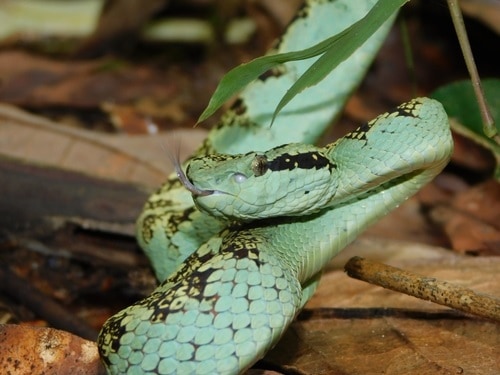
The Western Ghats mountain range lies in western India, and is a damp hilly range that runs for hundreds of miles from north to south. It’s a Unesco World Heritage site, one of 36 global biodiversity hotspots, with an endless cast of rare species found nowhere else.
Bizarre snakes that live here include the salty earth snake and Nilgiri keelback, and the Malabar pitviper (Craspedocephalus malabaricus) is the main endemic venomous snake. This species measures 40-80cm, and primarily inhabits wet evergreen forests, often with up to 10,000mm of rainfall annually.
Malabar pitvipers rest on branches for most of the day, sometimes up to 15 metres high. They’re an ambush predator which can go for months without eating, or even weeks without moving, waiting for the perfect opportunity with immense patience.
Local people call this snake “happatte havu”. In certain regions of the western Ghats, Malabar pitvipers can be extremely common, with several lurking in one forest corner, perhaps right above your head. Malabar pitvipers are dangerously venomous, though not quite as dangerous as the Indian cobra or saw-scaled viper. Unlike those two, they fail to qualify for India’s “big 4” of deadly snakes. But there’s one advantage Malabar pitvipers have other Indian snake: a gigantic amount of colour morphs.
| 2 | An incredibly variable snake |
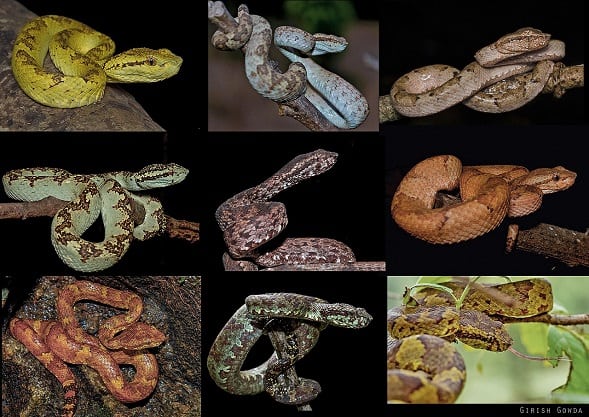
The Malabar pitviper is among the most variable snake species in the world, and probably in the top 5 for venomous snakes. Mottled brown is common, as is green. But inbetween, you have yellow, blue, orange, mixtures of pink and neon blue, and stony grey. There’s a fever among local Indian herpetologists for finding their favourite morph, particularly the sought-after yellow morph, which they achieve by stomping around a forest and meticulously scanning the branches for any weird flash of colour.
It’s only in adulthood that Malabar pitvipers bloom into this rainbow state, as newborns are a more consistent colour. They’re nearly always a mottled brown, typical of a viper, with no neon patches. For a couple of years, it’s pure anticipation; you won’t know what exact colour they’ll take until they reach adulthood.
These morphs aren’t different subspecies, as tests reveal no genetic seperation. Blue, orange and yellow can live together in the same forests, side by side. Males and females don’t discriminate by colour, and you can easily find banana yellow and electric blue ones together.
| 3 | But nobody knows why |
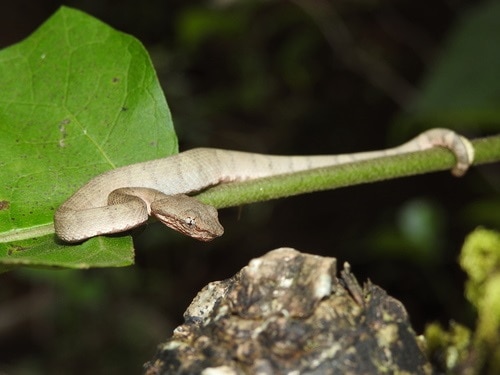
To identify Malabar pitvipers, scientists seek more consistent features like a triangular head, heat-seeking facial pits, and the precise arrangement of scales. A dark stripe stretching back from the eye is also near universal across the morphs. Then there’s the fact that they’re usually on branches, versus hump-nosed pitvipers which stick to the ground.
We know this species has immense variability from our eyes, but the exact mechanics are still very mysterious. Some have mentioned a gender divergence. Males tend to be browner, while females are more likely to have juicy jungle green scales. But this rule still isn’t consistent.
It’s even speculated that the colour variety is an anti-predator device, so that predators can’t code their appearance into their brains and instantly ID them. It’s possible that they change over the course of a year, like an Arizona black rattlesnake darkening in winter. People have noticed correlations with certain habitats, such as that those on the ground are browner, while those high in the canopies on mossy branches are mottled green. Their eye colour also varies, with blue eyes in blue morphs, golden eyes in brown morphs, etc, with the constant feature of vertical pupils.
| 4 | Nemesis: king cobra |
King cobras are one of the Malabar pitviper’s mortal foes. A telemetry study that radiotracked a king cobra over 3 months found that it ate 24 Malabar pitvipers during that time. King cobras are equally abundant in the western Ghats mountain range; in fact, this is the westernmost place they live on Earth, with the easternmost being the Philippines. The cobra also ate 2 hump-nosed vipers (Hypnale hypnale) over the 3 months.
The king cobras were expert trackers of Malabar pitvipers. Their default was to prowl the forest, constantly investigating objects like burrows, crevices and forest debris. When they detected a pitviper trial, their tongue flecking became far more intense, its head jerked, and its movements became more focussed, following a clear trail. This directly led it to resting Malabar pitvipers, which sometimes leapt from their branches the second they noticed the king cobra. One Malabar pitviper leapt 15 metres from its branch to avoid the king cobra’s clutches. Craspedocephalus malabaricus has a mortal nemesis, and they know it.
Of the 24 eaten, 17 were captured on trees, shrubs, vines and fallen branches, while 7 were scooped up on the ground. Some speculated that the king cobra scared the Malabar pitvipers on purpose, to make them easier to catch. King cobras were so attuned to Malabar pitviper scents that they could track them through a raging downpour.
| 5 | A frog-loving snake |
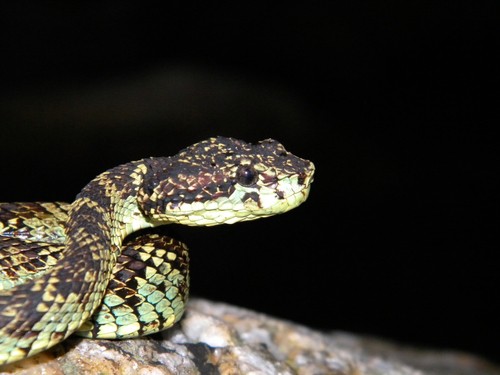
It’s been known for years that Malabar pitvipers prey on frogs, versus the king cobra eating fellow snakes, or the Russell’s viper focussing on mammals. A 2021 study made it official. It gathered 51 prey records for Malabar pitvipers, using scientific records, but mainly by scouring social media, on websites like Facebook, Flickr and YouTube. The records had to be a properly documented kill, reaching a high threshold of evidence.
The verdict was a diet of 74.5% anurans (toads and frogs), 13.7% reptiles, 7.8% mammals, and 3.9% other. The single most common species was the easily the Malabar gliding frog, at 16 records. In 2nd was Rao’s intermediate golden-backed frog, at 4 records, followed by the only confirmed mammal, an Asiatic long-tailed climbing mouse, at 2 records. All other frogs reached just 1 record, including the bicoloured frog and Indian bullfrog. The Malabar gliding frog completely dominated. The “other” category contained one land snail and one eel. 75% of prey were swallowed headfirst.
| 6 | Exceedingly patient and cautious |
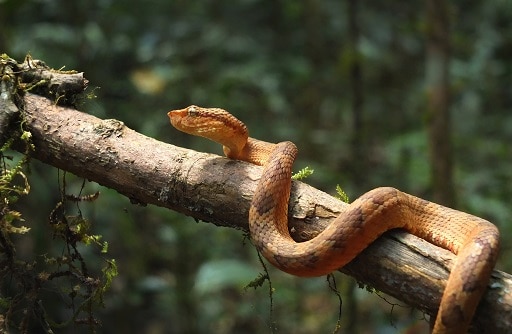
A 2020 sighting involved a Malabar pitviper resting on a branch in India’s Madei Wildlife Sanctuary. This was near a puddle containing Malabar gliding frogs, and a male then leaped onto the branch 30-35cm from the snake. The snake shifted its head slightly in the frog’s direction, but didn’t react otherwise. It was biding its time, waiting for the optimal time to strike.
6 minutes later, the snake hopped to within 10-12cm of the C. malabaricus. The pitviper struck, and seized the gliding frog in a struggle lasting 7 minutes. Then it swallowed, and from strike to complete ingestion, the process took 8 minutes, which is relatively fast for a snake. The Malabar pitviper was already 3 metres high, and it then climbed higher in order to digest.
Another tale from Madei Wildlife Sanctuary involved a Malabar pitviper positioned 1.7 metres high, on a small twiggy branch. A Bombay bush frog was crawling down a muddy embankment. Again, the pitviper only unleashed its strike at a close distance of 8cm, waiting for the last moment. The struggle lasted 6 minutes, and swallowing the frog fully took 4 minutes, again relatively quick. This time, the Malabar pitviper remained on its branch to digest its prey.
In both reports, the Malabar pitviper only commenced swallowing once the frog had stopped moving, waiting for the venom to take hold, rather than swallowing them while still writhing and kicking. The Indian checkered keelback often does the latter; sometimes you can hear frogs still croaking from inside its stomach.
| 7 | Underwater escapades |
The Malabar pitviper isn’t an aquatic snake in the slightest. Branches are their favourite, and they’re comfortable on the ground, but they’re not a swamp-lover like the cottonmouth. However, a 2011 study found that their diving abilities are surprisingly strong.
The story began with a Malabar pitviper resting by a small stream, about 35-45cm deep. A king cobra slithered past menacingly, and the pitviper stayed completely still, allowing it to go unseen. When the king cobra left, the 35-40cm pitviper entered the stream and submerged several times for 6 seconds. It swam a little way down the stream, attracted by the sight of a submerged branch.
Then it did something really surprising: it coiled its body around this underwater branch and entered ambush posture, with its body coiled like a spring. The pitviper’s entire body was underwater, and it didn’t surface again for 20 minutes. It was like it didn’t even realise that the branch was underwater, and was just excited over a great ambush spot. When it surfaced, it wasn’t gasping or breathing heavily. The Malabar pitviper has a surprisingly strong ability to hold its breath.
| 8 | Venom: swelling and blood clotting |
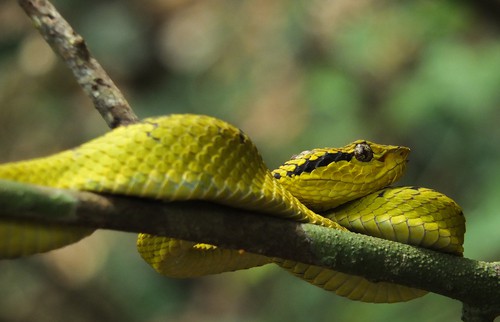
The venom of Malabar pitvipers isn’t fatal, but this hissing serpent can be a big threat to plantation and agricultural workers within forests. In some locations, they’re a force to be reckoned with with, as a study from Karnataka found that bite totals surpassed those from saw-scaled vipers and Indian kraits (members of the big 4). Typical symptoms of a bite include hypotension, gangrene, and mild kidney damage.
One case involved a 44 year old agricultural worker, who was bitten on the face. That side of his face plus the neck soon became massively swollen, so much that the man could barely open his eyes. The area surrounding the bite site was actually cooler, due to the influx of liquid in the swelling.
The man also experienced mild hypotension and blood clotting disruption, with tests revealing reduced levels of the clotting agent fibrinogen. This was backed up by another study, which found moderate anticoagulant properties in Malabar pitvipers. The venom was able to cleave through the 3 major fibrinogen forms: alpha, beta, and gamma.
| 9 | Milder than its neighbours |
While you should always be cautious while climbing trees in an Indian forest, the Malabar pitviper has caused no confirmed deaths on record.
A comparison to its Western Ghats neighbour, the hump-nosed viper, which sticks to the ground in forests, found a higher LD50 toxicity rating of 1.32mg in the latter, versus just 6.0mg for Malabar pitvipers, which is weaker than most rattlesnakes. However, this same study found that Malabar pitviper venom was 4 times stronger for haemorrhaging. This backs up the destruction of fibrinogen mentioned above. It was far weaker for necrosis, failing to cause skin tissue to die and slough off even in high doses.
All these experiments were conducted in mice. Last but not least, the study tested the main Indian and Sri Lankan polyvalent antivenoms, which are both forged using venom from the “big 4” species, injected into hyperimmunised horses. While weak against hump-nosed pitvipers, they were highly effective against Malabar pitviper venom, reducing the haemorrhaging by 50% in small doses.
| 10 | Causes just a few bites annually |
The Malabar region itself lies in Kerala state, southwest India, and is covered by a big chunk of the western Ghats. By gathering data from a government hospital from January 2012 to October 2016, scientists confirmed that C. malabaricus is a bit part player. 8 venomous snakes caused bites, with Russell’s vipers easily dominating, at 538 cases. 382 hospital patients had fallen foul of a common krait, 204 the India cobra and 104 the saw-scaled viper. That completes the “big 4”, and among secondary venomous snakes, hump-nosed pitvipers ruled at 224 bites, actually coming third. Malabar pitvipers, despite being very common in certain forests, caused just 26 bites across the near 5 year period. Also included were the bamboo pitviper (20) and banded krait (2).
Malabar pitvipers lay live young, in small batches of 3-5. They can reach over 2000 metres in the Western Ghats, and their Craspedocephalus family has 14 members, found from India to Indonesia. Malabar pitvipers were originally part of the Trimeresurus family, which includes the likes of large-eyed pitvipers from Bangkok, but switched to Craspedocephalus in 2014.
Then came another development: the Malabar pitviper was seperated into three species in 2021, found in different areas of the Western Ghats mountains. The three have similar lifestyles and habits, but subtle differences in scales and venom composition.
